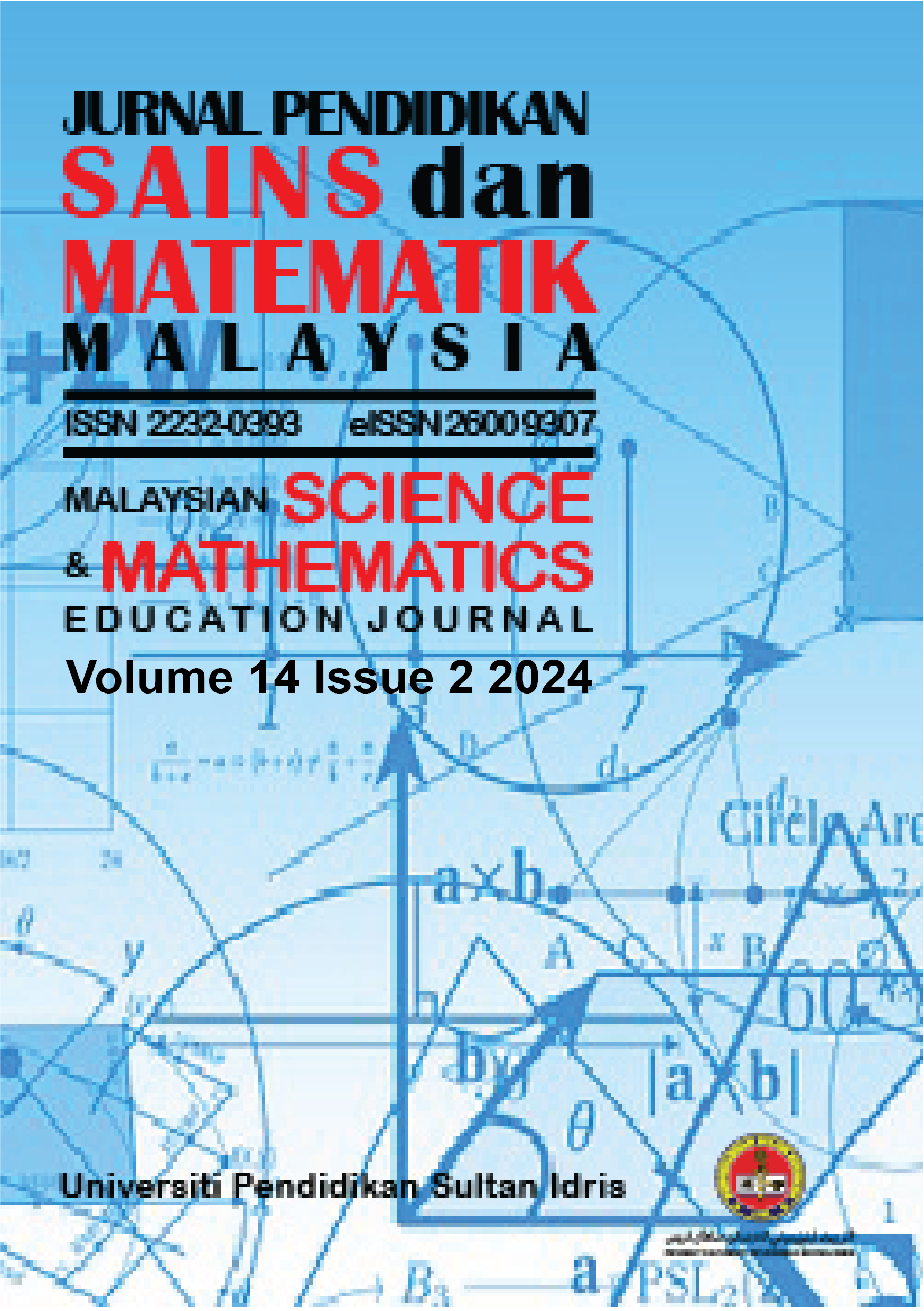Analysis of Form Two Mathematics Textbook Content for Functional Graph Topic using the Praxeology Method
DOI:
https://doi.org/10.37134/jpsmm.vol14.2.9.2024Keywords:
praxis block set (practical), logos block set (knowledge), Functional Graph topic, praxeology analysis methodAbstract
The use of the praxeology method is very important in knowing the delivery of the content contained in the textbook. However, there is still a lack of research on content analysis in Form Two Functional Graph Topic using the praxeology method. This study aims to analyze the Form Two Mathematics Textbook content for the topic of Functional Graph based on the praxeology method. Data collection was done by content analysis by categorizing the set of praxis (practical) blocks consisting of assignment types (T) and techniques (τ) as well as logos (knowledge) blocks consisting of technology (θ) and theory (Θ). The findings of the study show that there are 18 types of assignments (T), 13 techniques (τ), 10 technologies (θ), and eight theories (Θ) contained in the topic. This study found that six types of assignments (T) did not complete the categories in the prexeology method, one type of assignment (T) did not have technique (τ), one type of assignment (T) did not have theory (Θ) and four types of assignment (T) did not have all three categories of prexeology, namely technique (τ), technology (θ) and theory (Θ). Therefore, based on this study, if the assignment does not complete the praxeology category, it affects the knowledge gained by students in completing the assignment on the topic of Functional Graphs, in addition to facing the limitations of comprehensive knowledge. This research can guide interested institutions in formulating improvements to the content in the mathematics textbook for the topic of Form Two Functional Graph to improve students' understanding of the topic of Functional Graph. Keywords: praxis block set (practical), logos block set (knowledge), Functional Graph topic, praxeology method.
Downloads
References
Abdullah, A. H., Misrom, N. S., Kohar, U. H., Hamzah, M. H., Ashari, Z. M., Ali, D. F., Samah, N. A., Tahir, L. M., & Rahman, S. N. (2020). The effects of an inductive reasoning learning strategy assisted by the GeoGebra software on students’ motivation for the functional graph II topic. IEEE Access, 8, 143848-143861. https://doi.org/10.1109/access.2020.3014202
Agustika Siagian, Q., & Herman, T. (2023). Praxeological Analysis of Mathematics Textbooks for. Class XI High School Students on Arithmetic and Geometric Sequences. Eduma : Mathematics Education Learning and Teaching, 12(2), 139–152. https://doi.org/10.24235/eduma.v12i2.13
Ahmad Bakri, S. R., Chin Ying, L., Chee Khium, C., Moi Hua, T., & Siew Ching, L. (2021). Bridging the gap between the derivatives and graph sketching in calculus. Asian Journal of University Education, 16(4), 121. https://doi.org/10.24191/ajue.v16i4.11962
Azzahra, N., Herman, T., & Dasari, D. (2022). Analysis of Inverse Proportion in Mathematics Textbook Based on Praxeological Theory. Jurnal Analisa, 8(2), 152–167. https://doi.org/10.15575/ja.v8i2.22679
Baharam, B., Baharam, B., Ahmad, N. J., Mohd Tahir, N., & Mohd Hanafiah, M. N. (2017). Matematik Tingkatan 2 (1st ed.). Rimbunan Ilmu Sdn Bhd. https://anyflip.com/dznyj/pmoz
Ferrarello, D., Gionfriddo, M., Grasso, F., & Mammana, M. F. (2022). Graph theory and combinatorial calculus: an early approach to enhance robust understanding. ZDM – Mathematics Education, 54(4), 847–864. https://doi.org/10.1007/s11858-022-01407-w
HastiYunianta, T. N., Suryadi, D., Dasari, D., & Herman, T. (2023). Textbook praxeological-didactical analysis: Lessons learned from the Indonesian mathematics textbook. Journal on Mathematics Education, 14(3), 503–524. https://doi.org/10.22342/jme.v14i3.pp503-524
Hendriyanto, A., Suryadi, D., Dahlan, J. A., & Juandi, D. (2023). Praxeology review: Comparing Singaporean and Indonesian textbooks in introducing the concept of sets. Eurasia Journal of Mathematics, Science and Technology Education, 19(2). https://doi.org/10.29333/ejmste/12953
Hofer, B. K., & Pintrich, P. R. (1997). The development of epistemological theories: Beliefs about knowledge and knowing and their relation to learning. Review of Educational Research, 67(1), 88–140. https://doi.org/10.3102/00346543067001088
Katalenić, A., Milin Šipuš, Ž., & Čižmešija, A. (2020). Asymptotes and Asymptotic Behaviour in Graphing Functions and Curves: an Analysis of the Croatian Upper Secondary Education Within the Anthropological Theory of the Didactic. International Journal of Science and Mathematics Education, 18(6), 1185–1205. https://doi.org/10.1007/s10763-019-10020-5
Kementerian Pelajaran Malaysia (2016). Dokumen Standard Kurikulum dan Pentaksiran: Bahagian Pembangunan Kurikulum
Lian, L. H. (2019). Analisis Peringkat Kebolehan Penyelesaian Algebra Dalam Kalangan Pelajar Kolej Komuniti. Politeknik & Kolej Komuniti Journal of Life Long Learning, 3(1), 62-71.
Nicholas, J., Hunter, J., & Hargreaves, J. (2006). Functions and Their Graphs. Mathematics Learning Centre University of Sydney. https://www.sydney.edu.au/content/dam/students/documents/mathematics-learning-centre/functions-and-graphs.pdf
Pansell, A. (2023). Mathematical knowledge for teaching as a didactic praxeology. Frontiers in Education, 8. https://doi.org/10.3389/feduc.2023.1165977
Petersson, J., Sayers, J., Rosenqvist, E., & Andrews, P. (2021). Two novel approaches to the content analysis of school mathematics textbooks. International Journal of Research and Method in Education, 44(2), 208–222. https://doi.org/10.1080/1743727X.2020.1766437
Putra, Z. H., & Witri, G. (2017). Integrating Technology and Science into Early Childhood and Primary Education. https://www.researchgate.net/publication/317402123
Ridzuwan, A. Z., Halim, L., & Wan Mohammad, W. M. R. A Conceptual framework of teacher and student strategies in the use of science textbooks through a systematic literature review. Jurnal Pendidikan Sains Dan Matematik Malaysia, 14(2), 1–20. https://doi.org/10.37134/jpsmm.vol14.2.1.2024
Tay, Y. S., & Rosli, R. (2021). An Analysis on Cognitive Domain in the Topic of Money for Year 5 and Year 6 Mathematics Textbooks Revised KSSR 2017: Analisis Domain Kognitif Bagi Topik Wang Dalam Buku Teks Matematik Tahun 5 dan Tahun 6 KSSR Semakan 2017.Jurnal Pendidikan Sains Dan Matematik Malaysia, 1–21. https://doi.org/10.37134/jpsmm.vol12.2.1.2022
Trujillo, M., Atarés, L., Canet, M. J., & Pérez-Pascual, M. A. (2023). Learning Difficulties with the Concept of Function in Maths: A Literature Review. In Education Sciences (Vol. 13, Issue 5). MDPI. https://doi.org/10.3390/educsci13050495
Xu, M. (2021). Understanding Graph Embedding Methods and Their Applications. SIAM Review, 63(4), 825–853. https://doi.org/10.1137/20M1386062
Downloads
Published
How to Cite
Issue
Section
License
Copyright (c) 2024 Qamarina Dayana Shahrul, Nurihan Nasir, Didi Suryadi

This work is licensed under a Creative Commons Attribution-NonCommercial-ShareAlike 4.0 International License.





